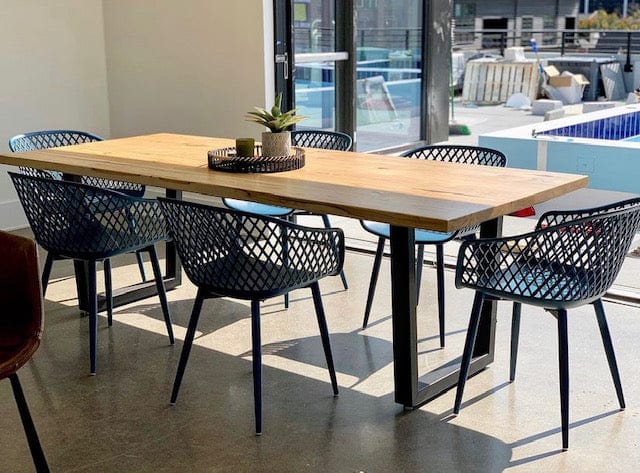Eating Table Legs: Exactly How to Select the Ideal Designs for Your Room
Selecting the appropriate table legs is important for both visual and practical consistency in your eating area. Whether your area flaunts a smooth, modern vibe or leans towards a much more conventional ambiance, the design of the legs can considerably influence the total appearance. Tapered legs exhibit contemporary style, while turned legs provide a nod to timeless charm. Past design, the material-- be it cozy timber or streamlined metal-- plays a critical role in setting the tone. Exactly how do you guarantee these elements complement your existing decor while supplying the necessary stability? The answer depends on a well balanced approach.
Analyzing Your Dining Space Style
How do you determine the ideal table legs for your space? The solution starts with an extensive analysis of your dining room style. A natural style makes certain that your table legs boost the overall aesthetic instead of encounter existing elements. Begin by observing the building features of your eating area. Exist popular characteristics such as subjected beam of lights, intricate moldings, or minimal lines? These details commonly determine whether a typical, rustic, contemporary, or industrial design is most proper.
Following, think about the existing furnishings and decoration. The materials, colors, and appearances within the area play a critical role. An eating space with sleek, contemporary chairs and metallic accents may profit from straightforward, structured table legs. Alternatively, a room filled up with vintage pieces and rich textiles may require luxuriant, sculpted legs.
Lighting additionally affects perception. All-natural light can accentuate specific products and coatings, while artificial lighting can highlight different elements. Account for the area's range and proportions. Huge, open eating areas can fit larger, much more considerable legs, whereas smaller areas need even more delicate, inconspicuous layouts. By carefully examining these variables, you can choose eating table legs that sympathetically blend with your dining-room's style.
Popular Leg Styles Clarified

One widespread design is the tapered leg, renowned for its streamlined, modern look. Next off, the turned leg functions detailed spindle-like styles, often found in traditional and farmhouse settings.
Cabriole legs, with their distinct curves, are identified with French Provincial and Queen Anne furniture. Their elegant, flowing lines bring a sense of elegance and historical charm (dining room table legs). For those favoring a durable and simple design, square legs offer strong assistance and a clean, geometric appearance, suitable for commercial or minimalist spaces
Last but not least, hairpin legs offer a retro, mid-century modern vibe. Made from steel, these legs are both light-weight and solid, adding a distinct aesthetic comparison to wooden tabletops. Comprehending these designs will assist you in selecting eating table legs that boost your space's aesthetic and performance.
Product Factors To Consider

Steel legs, usually made from stainless steel, iron, or aluminum, give a modern and industrial look while making sure robust support. They are usually much more resistant to use and tear, making them a long lasting option.

Other products like bamboo or rattan provide eco-friendly choices, bringing a natural and kicked back vibe to the dining location. Each material has its pros and disadvantages, and the best Check Out Your URL selection will depend upon your specific requirements and choices.
Balancing Aesthetics and Performance
Attaining the ideal equilibrium in between aesthetic appeals and capability is vital when selecting table legs. While the visual charm of table legs can dramatically enhance the general setting of an eating space, their practical elements can not be overlooked. The style of the legs should integrate with the room's design, yet they need to also offer appropriate assistance and security for the table.
Consider the architectural design of your area. Smooth, contemporary insides might profit from minimalist, metal legs that provide a clean and unobtrusive look. On the various other hand, standard setups usually complement turned or carved wood legs that include a touch of elegance and sophistication.
Functionality encompasses the stability and resilience of the legs. For instance, trestle legs, understood for their toughness, can offer strong support for larger tables, making them perfect for families or frequent entertainers. dining room table legs. Alternatively, pedestal legs can use even more legroom and versatility, enabling better seats plans
Furthermore, the height and positioning of the legs are crucial for comfy eating. click here to find out more Legs put as well much inward may hinder seats, while those also close to the side can limit activity. Thus, thoughtful factor to consider of both aesthetic and useful elements is extremely important for an optimum eating experience.
Customization and Do It Yourself Options
Modification opens a realm of opportunities for developing dining table legs that are distinctively customized to your preference and needs. Specific style components, such as turned legs, tapered shapes, or complex makings, can be incorporated to show your style.
For visite site those likely in the direction of do-it-yourself (DIY) jobs, producing personalized table legs uses both a gratifying experience and the possibility to achieve a bespoke aesthetic. Do it yourself fanatics can resource basic materials and utilize woodworking or metalworking tools to craft legs that satisfy exact requirements. In addition, numerous online tutorials and workshops offer guidance, making the process a lot more obtainable for newbies.
Inevitably, whether choosing professional customization or starting a DIY venture, the ability to tailor table legs ensures that the end product integrates with your indoor design vision, enhancing both functionality and aesthetic allure.
Verdict
Picking the ideal eating table legs calls for cautious consideration of the overall style of the dining-room, consisting of existing architectural features and furnishings. Recognizing prominent leg styles and material alternatives is crucial for attaining an unified aesthetic. Balancing aesthetics with capability makes certain stability and enhances the eating experience. Personalization choices even more enable a tailored layout. Eventually, the chosen table legs should enhance the design, providing both aesthetic charm and practical assistance.